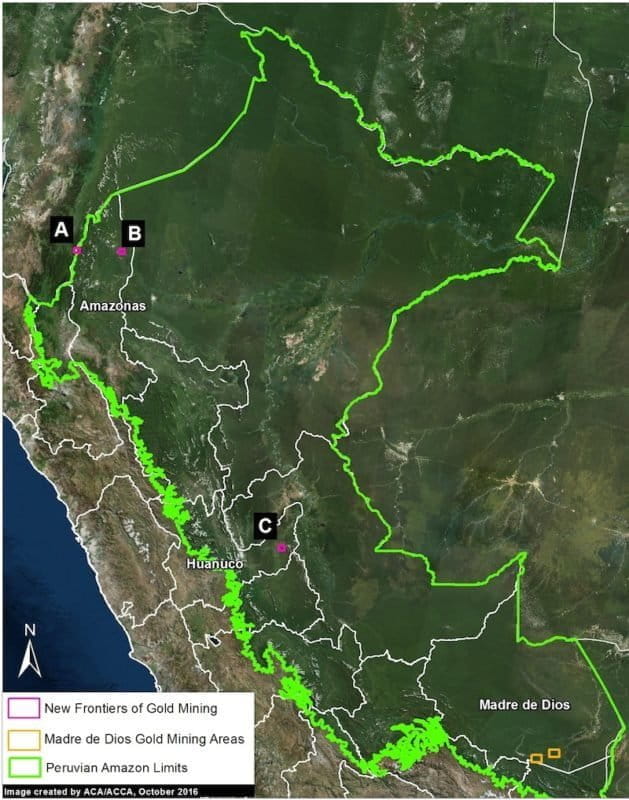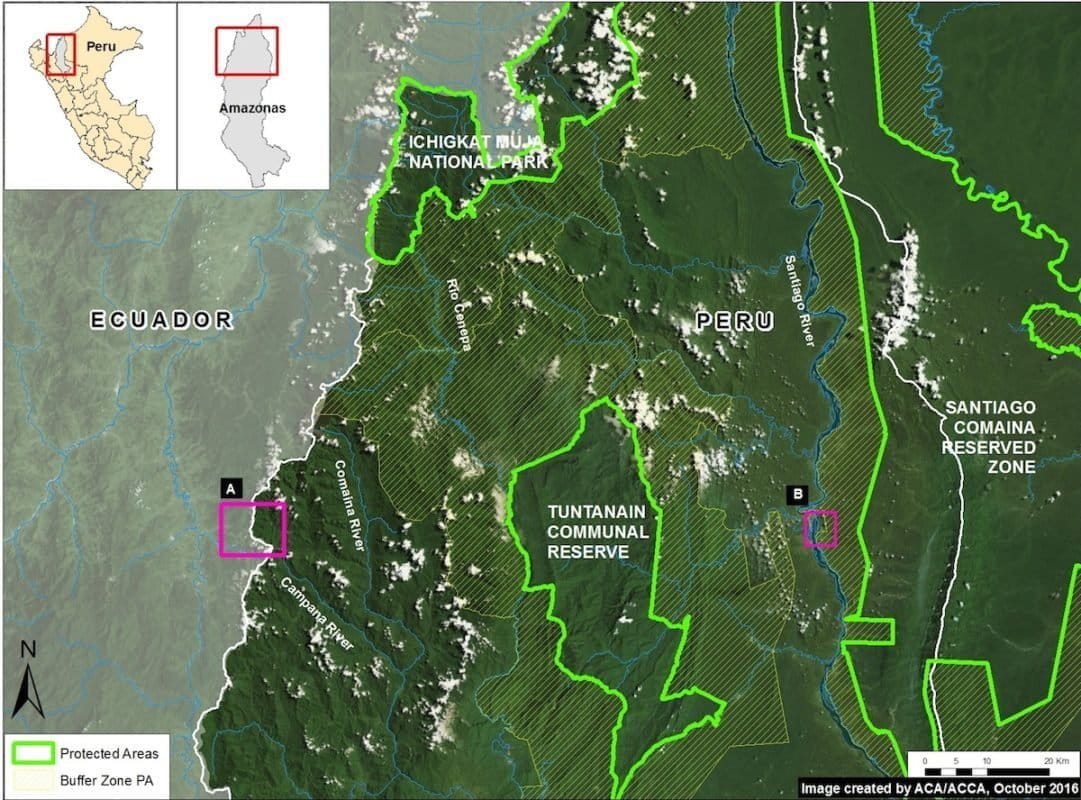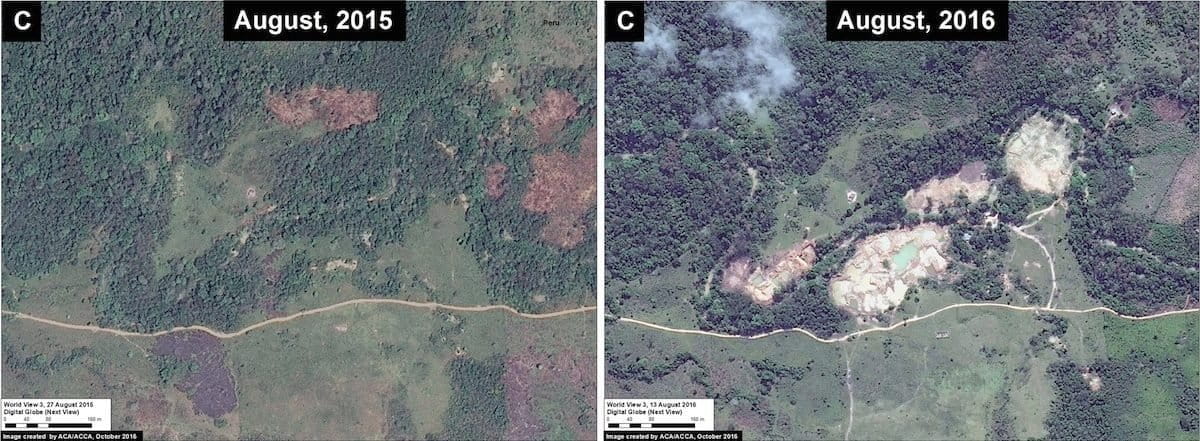- Gold mining – much of it illegal – is commonplace in several spots in southern Peru’s Made de Dios Department. The practice has resulted in vast deforestation and river degradation, and released harmful levels of mercury into water sources.
- A recent analysis of satellite data indicates gold mining is spreading northwards, with three operations spotted in the Amazonas and Huánuco regions. Two of these are mining illegally in protected areas.
- So far, the researchers estimate around 44 hectares of rainforest have been displaced by these operations. They write that there’s still time to stop them before they get larger.
Illegal gold mining in Peru – once restricted to the southern states – is now spreading across new territory in the northern and central Peruvian Amazon. In a report released earlier this month, Monitoring of the Andean Amazon Project (MAAP) revealed three new “frontiers” of gold mining in the departments of Amazonas and Huánuco – regions that boast exceptional biological and cultural diversity.
Across the frontiers, MAAP detected 32 hectares of mining deforestation – an area equivalent to about 42 soccer fields. These mining scars are fresh, and relatively small, indicating that a larger-scale deforestation event can still be prevented.
“Deforestation in these cases is still in its early stages, so there is still time to avoid larger-scale damage, as in the case of [the southern region of] Madre de Dios,” the report states.

The Department of Madre de Dios has long been subject to illegal gold mining, where an estimated 30,000 artisanal miners operate illicitly. The outfall from mining gained international visibility earlier this year when the government declared a state of emergency for the region after detecting dangerous levels of mercury – used to extract gold from sediment – within local communities. The region’s forests, rivers, and biodiversity have also paid a price.
According to MAAP’s latest report, gold mining activity now appears to be contributing to deforestation in two new regions of the country: Amazonas and Huánuco. These incursions are the first of their kind in northern and central Peru.
“These represent the only known cases of gold mining deforestation outside of the main mining zone in the South,” Matt Finer, lead MAAP researcher and co-author of the report, said in an email to Mongabay. “There is gold mining in the rivers of some other areas, but these are the only three cases actually causing deforestation.”
Gold mining in Amazonas
To date, mining activity has razed 22 hectares of forest across the northern Department of Amazonas, MAAP writes. Gold mining scars – legal and illegal – were detected in the mountain range, known as “Cordillera del Cóndor,” (denoted by “A” in the image below) and along the banks of the Santiago River in the buffer zone of the Santiago Comaina reserve (B)

Mining along the Santiago River – first detected by MAAP in June – represents the earliest known case of mining deforestation in northern Peru. Today, deforestation paces ahead, despite claims that illegal mining threatens some 70,000 residents of the local Awajun and Wampis indigenous communities who depend on the river for water, food, and bathing.
Consistent with MAAP’s report, the University of Maryland’s Global Land Analysis and Discovery (GLAD) dataset indicates that forest loss spread to this region over the last few months. Since July, several GLAD alerts – each pointing to an area where tree cover loss has likely occurred – were detected in the buffer zone where MAAP reported incursion.


The mining along the Santiago River is likely illegal, according to Esteban Valle Riestra, a consultant with the Lima-based organization DAR.
“[In the region MAAP depicts], there are two mining concessions, but the people working there are not legal,” he told Mongabay. “They’re not paying taxes or following the environmental standards.”
According to Riestra, legal gold miners must abide by environmental standards that limit deforestation and harmful extraction practices, such as dredging up sediment. But illegal miners defy these safeguards, leaving “not a single tree standing.”
Military forces were deployed in September to stymie the illegal activity along the Santiago River, MAAP writes. However, similar interventions have failed in the past, leaving Riestra less hopeful for the future.
“When police come to the [mining] camps, the miners just move elsewhere,” he said. “When they know the police are gone, the miners come back and continue their activity.”
MAAP also detected fresh mining scars in the biodiverse region of Cordillera del Cóndor – a mountain range along the northern border of Peru. In this case, mining activities – driving deforestation of 12 hectares to date – may be legal.

According to Frederica Barclay of the Peruvian-based human rights organization, EQUIDAD, deforestation occurred within a concession owned by mining company Afrodita.
“It’s not illegal,” Barclay told Mongabay. “If Afrodita has authorization [through mining concessions], and this is a forest area, they can in fact [deforest the land].”
But Afrodita’s activity does not come without controversy, she said. According to Barclay, the company has skirted environmental regulations and conspired with the regional government to continue extractive activity, despite pressure from indigenous groups who rely on the nearby Cenepa river basin.
In the region of Cordillera del Cóndor, the abundant diversity of plants and animals is also at stake. Data from the University of Maryland and the Global Forest Watching platform revealed that the vast majority of recent mining deforestation occurred within “Intact Forest Landscapes” – the last expanses of particularly large, unbroken forests said to retain near-native levels of biodiversity. Since June, 57 GLAD deforestation alerts were detected where MAAP reported invasion, demonstrating the impact allegedly legal mining can have on native Amazonian forests.

Gold mining in Huánuco
MAAP also identified a mining frontier in the central Peruvian region of Huánuco. According to their report, gold miners have infiltrated the buffer zone of El Sira Communal Reserve, a protected area inhabited by the Ashaninka, Yanesha, and Shipibo-Conibo indigenous groups.
This isn’t the first time MAAP has detected deforestation in the El Sira region. Back in September, the team documented forest incursion – on the scale of 1,600 hectares – in the reserve itself, pegging agriculture as the primary driver. According to MAAP’s previous report, the government has managed to minimize illegal gold mining activity inside the boundaries of the protected area.
But the buffer zone remains at risk. Over the last year, gold miners razed 10 hectares of forest in this region, MAAP writes, representing the first indication that mining deforestation is spreading to central Peru.

Peru is the leading gold producer in Latin America, and one of the top producers in the world. Much of this gold comes from illegal or “informal” mining. By one estimate, 28 percent of gold produced in Peru is illegal, with an export value now exceeding that of cocaine.
The environmental cost of illegal gold mining in Peru – now expanding in northern and central regions – has been significant. In Madre de Dios alone, illegal miners have cleared at least 50,000 hectares of Amazonian forest in search of gold flecks, which continue to fetch a high price in markets worldwide. According to Riestra, illegal mining is not likely to slow anytime soon.
“If the price of gold remains high, mining production will continue for a long time, and expand,” Riestra said. “The first spot was Madre de Dios, but now it’s expanding to other areas of the Amazon.”
The central and northern mining frontiers – in Amazonas and Huánuco – have not yet reached the scale of those in Madre de Dios. This is good news, MAAP writes, because there’s still time to avoid a sweeping deforestation event, which have become all too common in other regions of Peru.
For Riestra, the solution is stronger government intervention.
“We need to try and strengthen the enforcement agencies,” he said. “If we have the chance to reinforce these agencies [that stymie illegal mining], there might be a way to resolve the problem. These crimes can’t go unpunished.”
Citation:
- Novoa S, Finer M (2016) New Frontiers of Gold Mining in the Peruvian Amazon. MAAP: 49
Banner image is of illegal gold mining in Madre de Dios, taken by Rhett A. Butler













